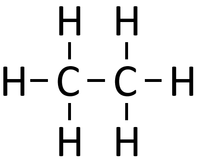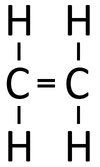Difference between revisions of "Cracking"
(→Examples) |
(→Examples) |
||
| Line 26: | Line 26: | ||
Hexadecane → Decane + Hexene | Hexadecane → Decane + Hexene | ||
| − | <chem>C16H34 -> C10H22 + C6H12</chem> | + | : <chem>C16H34 -> C10H22 + C6H12</chem> |
Hexadecane → Decane + Butene + Ethene | Hexadecane → Decane + Butene + Ethene | ||
| − | <chem>C16H34 -> C10H22 + C4H8 + C2H4</chem> | + | : <chem>C16H34 -> C10H22 + C4H8 + C2H4</chem> |
Decane → Pentane + Pentene | Decane → Pentane + Pentene | ||
| − | <chem>C10H34 -> C5H12 + C5H10</chem> | + | : <chem>C10H34 -> C5H12 + C5H10</chem> |
Decane → Hexane + Butene | Decane → Hexane + Butene | ||
| − | <chem>C10H34 -> C6H14 + C4H8</chem> | + | : <chem>C10H34 -> C6H14 + C4H8</chem> |
Revision as of 10:30, 25 January 2019
Key Stage 4
Meaning
Cracking is a Thermal Decomposition process in which large hydrocarbon molecules are broken into smaller hydrocarbon molecules.
About Cracking
- Cracking is often done because Crude Oil contains more large hydrocarbon molecules than can be used and not enough short hydrocarbon molecules than are needed.
- When Crude Oil fractions are cracked the long alkanes are broken down into smaller alkanes and alkenes.
- Cracking is done at very high temperatures (500°C) and uses either a catalyst to aid the reaction or steam.
- When an alkane is cracked into smaller pieces there are not enough Hydrogen [[atom]s to produce two saturated hydrocarbons. One of the hydrocarbons must be unsaturated and therefor will have a double bond.
Examples
| If butane were cracked. | An alkane and an alkene are produced. | |||
Cracking a hydrocarbon can produce many possible products:
Hexadecane → Decane + Hexene
- <chem>C16H34 -> C10H22 + C6H12</chem>
Hexadecane → Decane + Butene + Ethene
- <chem>C16H34 -> C10H22 + C4H8 + C2H4</chem>
Decane → Pentane + Pentene
- <chem>C10H34 -> C5H12 + C5H10</chem>
Decane → Hexane + Butene
- <chem>C10H34 -> C6H14 + C4H8</chem>



